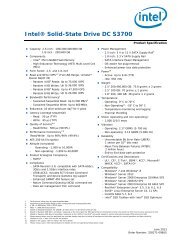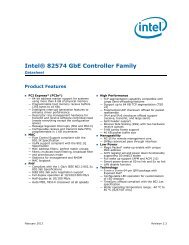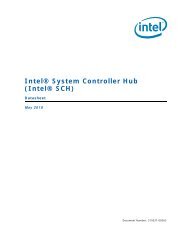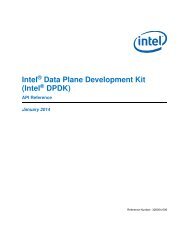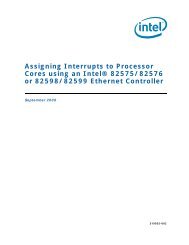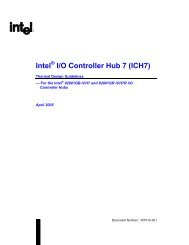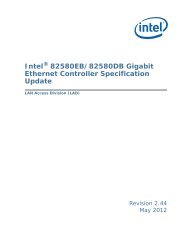Intel Itanium Processor 9300 Series and 9500 Series
Intel Itanium Processor 9300 Series and 9500 Series
Intel Itanium Processor 9300 Series and 9500 Series
Create successful ePaper yourself
Turn your PDF publications into a flip-book with our unique Google optimized e-Paper software.
Introduction<br />
The <strong>Intel</strong> ® <strong>Itanium</strong> ® <strong>Processor</strong> <strong>9500</strong> <strong>Series</strong> delivers increased levels of flexibility,<br />
reliability, performance, <strong>and</strong> cost-effective scalability for your most data-intensive<br />
business <strong>and</strong> technical applications.<br />
The <strong>Intel</strong> ® <strong>Itanium</strong> ® <strong>Processor</strong> <strong>9500</strong> <strong>Series</strong> processor provides up to 32 megabytes LLC<br />
cache, Hyper-Threading Technology for increased performance, <strong>Intel</strong> ® Virtualization<br />
Technology for improved virtualization, <strong>Intel</strong> ® Cache Safe Technology for increased<br />
availability. <strong>Intel</strong> ® Turbo Boost Technology, featuring sustained boost. The <strong>Intel</strong> ®<br />
<strong>Itanium</strong> ® <strong>Processor</strong> <strong>9500</strong> <strong>Series</strong> employs advanced power monitoring <strong>and</strong> control to<br />
deliver a higher processor frequency at all times, for maximum performance on all<br />
workloads. The result is a higher thermal envelope utilization for more overall<br />
performance. The <strong>Intel</strong> ® <strong>Itanium</strong> ® <strong>Processor</strong> <strong>9500</strong> <strong>Series</strong> offers large cache arrays<br />
covered by ECC including the large LLC utilizing double correct/triple detect (DECTED)<br />
<strong>and</strong> protecting the MLI/MLD with in-line single correct/double detect (SECDED). In<br />
addition, the processor provides extensive parity protection <strong>and</strong> parity interleaving on<br />
nearly all RFs, end-to-end parity protection with recovery-support on all critical internal<br />
buses <strong>and</strong> data paths including the ring. Residue protection on Floating Point unit,<br />
along with the adoption of radiation-hardened (RAD) sequential latching elements for<br />
vulnerable architectural <strong>and</strong> state. The <strong>Intel</strong> ® <strong>Itanium</strong> ® <strong>Processor</strong> <strong>9500</strong> <strong>Series</strong><br />
processor interfaces exclusively with the Ararat II Voltage Regulator Module.<br />
The <strong>Intel</strong> ® <strong>Itanium</strong> ® <strong>Processor</strong> <strong>9500</strong> <strong>Series</strong> consists of up to 8 core processors <strong>and</strong> a<br />
system interface unit. Each processor core provides a 12-wide, 11-stage deep<br />
execution pipeline. The resources consist of six integer units, one integer multiply unit,<br />
four multimedia units, two load/store units, three branch units <strong>and</strong> two floating-point<br />
units each capable of extended, double <strong>and</strong> single precision arithmetic. The hardware<br />
employs dynamic prefetch, branch prediction, a register scoreboard, <strong>and</strong> non-blocking<br />
caches to optimize for compile-time non-determinism. 32 additional stacked general<br />
registers are provided over the <strong>Intel</strong> ® <strong>Itanium</strong> ® <strong>Processor</strong> <strong>9300</strong> <strong>Series</strong>, <strong>and</strong> hardware<br />
support is provided for denormal, unnormal, <strong>and</strong> pseudo-normal oper<strong>and</strong>s for floating<br />
point software assist offloading.<br />
New instructions on the <strong>Intel</strong> ® <strong>Itanium</strong> ® <strong>Processor</strong> <strong>9500</strong> <strong>Series</strong> simplify common tasks.<br />
They include: clz (count leading zeros), mpy4 <strong>and</strong> mpyshl4(unsigned integer multiply/<br />
shift <strong>and</strong> multiply), mov-to-DAHR/mv-from-DAHR (for improved MLD/FLD prefetcher<br />
hinting <strong>and</strong> performance), <strong>and</strong> hint@priority (used by the processor to temporarily<br />
allocate more resources to a thread). Advanced Explicitly Parallel Instruction<br />
Computing (EPIC) is enhanced on the <strong>Intel</strong> ® <strong>Itanium</strong> ® <strong>Processor</strong> <strong>9500</strong> <strong>Series</strong> by<br />
increasing the capacity of retiring instructions per cycle from 6 to a maximum of 12<br />
instructions per cycle per core.<br />
<strong>Intel</strong> ® Hyper-threading Technology is enhanced in the <strong>Intel</strong> ® <strong>Itanium</strong> ® <strong>Processor</strong> <strong>9500</strong><br />
<strong>Series</strong> with dual domain multithreading, which enables independent front-end <strong>and</strong><br />
back-end pipeline execution to improve multi-thread efficiency <strong>and</strong> performance for<br />
both new <strong>and</strong> legacy applications. It provides hardware support for two threads per<br />
core, with a threaded 96 entry per thread Instruction Buffer <strong>and</strong> threaded MLDTLB <strong>and</strong><br />
FLDTLB, <strong>and</strong> a dedicated load return path from the MLD to the integer register file.<br />
Three levels of on-die cache minimize overall memory latency, with 16 KB instruction<br />
cache FLI/16 KB write-through data cache FLD that comprise the FLC <strong>and</strong> 512 KB MLI/<br />
256 KB writeback data cache MLD that comprise the MLC.<br />
The <strong>Intel</strong> ® <strong>Itanium</strong> ® <strong>Processor</strong> <strong>9500</strong> <strong>Series</strong> offers a new RAS feature: <strong>Intel</strong> ®<br />
Instruction Replay Technology. Pipeline replay resolves stall conditions that occur when<br />
the microprocessor pipeline encounters a resource hazard that prevents immediate<br />
execution. In a replay, the instruction that encountered the resource hazard is removed<br />
from the pipeline, along with all the instructions that come after it. The instruction is<br />
then read again out of the instruction buffer for replay <strong>and</strong> re-executed. To ensure a<br />
14 <strong>Intel</strong> ® <strong>Itanium</strong> ® <strong>Processor</strong> <strong>9300</strong> <strong>Series</strong> <strong>and</strong> <strong>9500</strong> <strong>Series</strong> Datasheet



